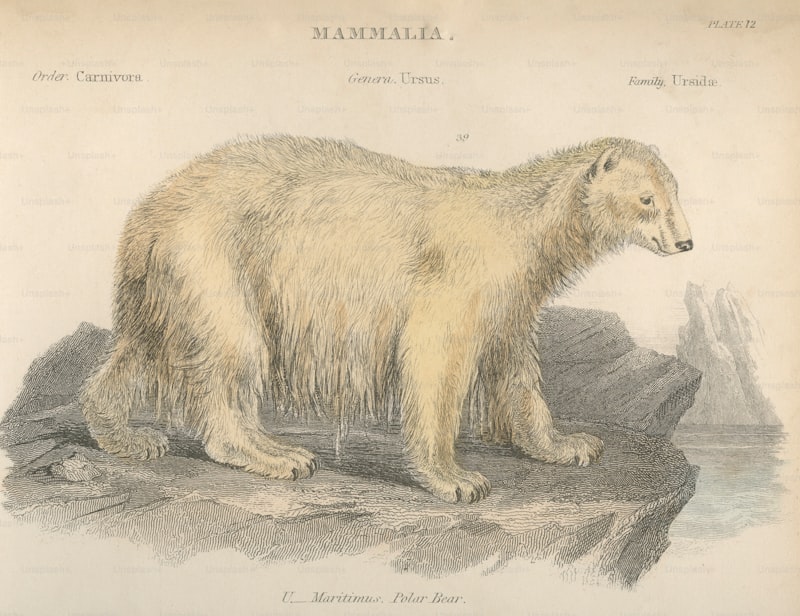Ever wondered how Arctic mammals like polar bears and walruses thrive in some of the world’s harshest environments? Their physiology holds fascinating secrets that enable them to survive in extreme cold and navigate icy waters with ease.
One of the most remarkable adaptations of Arctic mammals is their thick layer of insulating blubber. This specialized fat layer not only keeps them warm but also serves as an energy reserve during times of scarcity. It’s like nature’s built-in thermal jacket, allowing them to maintain a stable body temperature even when exposed to freezing temperatures.
Another key adaptation is their fur or skin structure. Polar bears, for example, have translucent fur that appears white but actually lacks pigment. This adaptation helps them blend into their snowy surroundings while effectively trapping heat from the sun. In contrast, animals like walruses have a thick layer of wrinkled skin that helps regulate body temperature by controlling blood flow near the skin surface.

Arctic mammals also excel in managing water loss. Unlike many other mammals, they have highly concentrated urine and can go extended periods without drinking freshwater by obtaining water from their food sources. This adaptation is crucial in an environment where liquid water is scarce but ice and snow are abundant.
Furthermore, their metabolic rates are uniquely adjusted to cope with long periods of fasting during the Arctic winter. They can slow down their metabolism significantly to conserve energy when food is scarce, allowing them to survive on stored fat reserves until conditions improve.
In essence, the comparative physiology of Arctic mammals showcases nature’s incredible ability to adapt to even the most challenging environments. From their specialized insulation and water management systems to their metabolic flexibility, these animals embody the resilience needed to thrive in the Arctic’s icy realms.
Surviving the Cold: How Arctic Mammals Adapt Physiologically
Ever wondered how Arctic mammals like polar bears and Arctic foxes thrive in the frigid temperatures of their icy habitats? It’s a marvel of evolutionary adaptation, where these creatures have developed incredible physiological mechanisms to withstand the harsh conditions of the Arctic.
One of the most striking adaptations is their thick fur coats. Unlike the fur of their warmer-climate relatives, the fur of Arctic mammals is dense and multi-layered, providing exceptional insulation against the biting cold. This insulation not only keeps them warm but also reduces heat loss to the environment, crucial for maintaining body temperature in freezing conditions.
Beyond their fur, Arctic mammals have also evolved specialized circulatory systems. Take the Arctic fox, for example. It has a counter-current heat exchange system in its paws, where warm blood from the body flows next to cold blood returning from the extremities. This ingenious adaptation prevents heat loss through the paws, ensuring that vital warmth is retained within the body.
Polar bears, the largest land predators on Earth, have adapted in another remarkable way. They possess a thick layer of blubber beneath their skin, which acts as both insulation and energy storage. This layer of fat not only keeps them warm but also serves as a reservoir of energy during periods of scarce food availability in the Arctic.
Furthermore, Arctic mammals have adapted their metabolism to cope with extreme cold. They can enter a state of lowered metabolism, known as torpor, during periods of food scarcity or intense cold. This allows them to conserve energy until conditions improve, ensuring survival in the challenging Arctic environment.
Heat Retention Secrets: Comparative Physiology of Arctic Mammals Revealed
One of the most striking features of Arctic mammals is their thick fur coats. Take the polar bear, for instance. Its dense fur not only provides insulation against the biting cold but also traps a layer of warm air close to its body. This natural insulation helps the polar bear maintain its body temperature even in subzero temperatures, allowing it to thrive in its icy habitat.
Another fascinating adaptation is the phenomenon of countercurrent heat exchange found in Arctic mammals’ extremities. This mechanism involves the circulation of warm arterial blood and cold venous blood in close proximity within blood vessels. As warm blood flows towards the extremities, it transfers its heat to the cold blood returning to the body. This ingenious exchange minimizes heat loss and ensures that vital organs remain warm, even when the animal’s extremities are exposed to freezing temperatures.
Arctic mammals also possess specialized metabolic adaptations that enhance heat production. Brown adipose tissue, commonly known as brown fat, plays a crucial role in generating heat through non-shivering thermogenesis. Unlike white fat used for energy storage, brown fat is packed with mitochondria that produce heat when activated by cold temperatures or certain hormones. This adaptive trait helps Arctic mammals maintain their core body temperature in extreme cold conditions.
The comparative physiology of Arctic mammals unveils nature’s awe-inspiring solutions to the challenges of extreme cold. From their insulating fur coats to intricate heat exchange mechanisms and efficient brown fat utilization, these animals embody resilience in the face of adversity. By unraveling these heat retention secrets, scientists gain deeper insights into evolutionary adaptations and potential applications for human thermal regulation research.
Beyond Fur: Exploring Arctic Mammals’ Unique Biological Adaptations
When we think of Arctic mammals, the first thing that often comes to mind is their thick fur, which indeed plays a crucial role in their survival. However, these fascinating creatures have evolved a plethora of other remarkable biological adaptations that enable them to thrive in one of the harshest environments on Earth.
Take the polar bear, for instance. Its iconic fur, consisting of dense underfur and guard hairs, not only provides insulation but also helps it blend into its snowy surroundings. Yet, it’s not just about fur. Polar bears possess a thick layer of fat beneath their skin, acting as a potent energy reserve and insulation against the freezing Arctic waters. This adaptation allows them to swim for long distances and endure extreme cold without losing body heat.
Moving to the Arctic fox, another master of adaptation. Despite its small size, this cunning creature boasts one of the warmest coats among mammals. Its fur changes color with the seasons, from brown in summer to white in winter, camouflaging it against the icy landscape and enabling effective hunting of prey like lemmings and birds. But wait, there’s more. The Arctic fox has specialized fur on its paws, providing traction on ice and snow, essential for navigating its icy habitat with agility.
Then there’s the mighty walrus, equipped with impressive tusks that serve multiple functions. These elongated canine teeth are used for hauling their massive bodies out of water onto sea ice, as well as for defense and dominance displays among their peers. Beyond their tusks, walruses possess a thick layer of blubber that insulates and buoyancies them in the frigid Arctic waters, aiding their diving abilities to forage for clams and mollusks on the ocean floor.
What about the beluga whale? Known as the “canary of the sea” due to its vocalizations, this Arctic cetacean boasts a unique adaptation in its flexible neck vertebrae, allowing it to turn its head in all directions. This capability is crucial for navigating through sea ice and hunting fish in the dark Arctic waters.
These examples demonstrate just a glimpse of the diverse and ingenious adaptations Arctic mammals have evolved to survive in their extreme environment. From specialized fur and insulation to unique skeletal features and hunting techniques, each species has carved out its niche in this frozen wilderness through millions of years of evolution.
Cold Climate Champions: Arctic Mammals and Their Remarkable Survival Strategies
Take the polar bear, the largest land carnivore on Earth. Its thick, insulating fur and a substantial layer of blubber act as natural armor against the biting cold. This adaptation not only keeps it warm but also buoyant when swimming between ice floes in search of seals, its primary prey.
Equally remarkable is the Arctic fox, known for its ability to survive in temperatures as low as -50°C (-58°F). Its fluffy fur changes color with the seasons, helping it blend seamlessly into the snowy landscape to evade predators and sneak up on prey. In summer, the fox’s brown coat provides camouflage among the tundra’s sparse vegetation.

The Arctic hare, another cold weather champion, relies on its long, thick fur and large, furry feet to traverse the snowy terrain with ease. These adaptations allow it to maintain warmth and move swiftly, evading predators like the Arctic wolf and snowy owl.
For all these Arctic mammals, adaptation isn’t just about physical traits but also behavioral strategies. Many species have mastered the art of conserving energy during the long winter months when food is scarce. They enter a state of reduced metabolic activity, minimizing energy expenditure until conditions improve.
Frequently Asked Questions
How do Arctic mammals manage energy expenditure during periods of scarcity?
Arctic mammals manage energy expenditure during periods of scarcity by reducing activity levels, relying on fat reserves built during periods of plenty, and conserving energy through physiological adaptations like decreased metabolism and insulation from thick fur or blubber.
What role does blubber play in the survival of Arctic marine mammals?
Learn about the crucial role blubber plays in the survival of Arctic marine mammals. Discover how this specialized fat layer insulates against the extreme cold, provides energy reserves, and aids buoyancy and streamlined swimming in frigid waters.
What are some unique physiological traits of Arctic mammals compared to other mammals?
Explore unique physiological traits of Arctic mammals such as thick insulating fur, specialized circulatory systems to conserve heat, and reduced extremity size to minimize heat loss. These adaptations enable survival in extreme cold environments.
How do Arctic mammals regulate their body temperature in freezing environments?
Arctic mammals regulate their body temperature through several physiological adaptations. These include thick layers of insulating fur or blubber, reduced blood flow to extremities to minimize heat loss, and a lower metabolic rate during periods of rest. Some species also have counter-current heat exchange systems in their limbs to prevent heat loss.
What adaptations do Arctic mammals have to survive extreme cold?
Learn about the unique adaptations Arctic mammals have developed to survive extreme cold climates, including thick layers of blubber for insulation, compact body shapes to conserve heat, and specialized fur that traps air for extra warmth.


